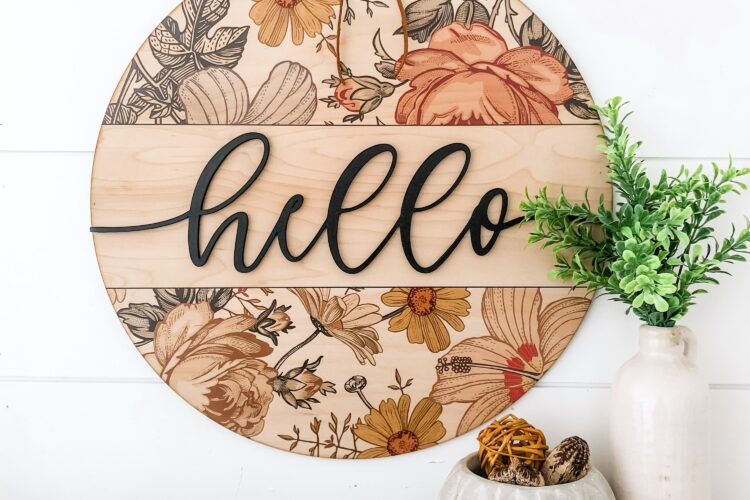
I. Introduction to Round Wood for Signs
A. Explanation of round wood for signs
B. Importance of round wood for signs in wayfinding and branding
II. Types of Round Wood for Signs
A. Natural edge round wood signs
B. Sandblasted round wood signs
C. Routed round wood signs
III. Benefits of Using Round Wood for Signs
A. Aesthetic appeal and unique character
B. Durability and weather resistance
C. Eco-friendliness and sustainability
IV. Designing with Round Wood for Signs
A. Choosing the right size and shape
B. Incorporating graphics, text, and logos
C. Selecting appropriate colors and finishes
V. Installing Round Wood for Signs
A. Choosing the right mounting hardware
B. Proper placement and alignment
C. Maintenance and upkeep
VI. Case Studies of Successful Round Wood Sign Projects
A. Examples of effective round wood sign usage
B. Lessons learned and best practices
VII. Where to Buy Round Wood for Signs
A. Local suppliers and manufacturers
B. Online retailers and marketplaces
C. Custom ordering options and turnaround times
I. Introduction to Round Wood for Signs
Have you ever noticed how certain signs seem to stand out from the rest, capturing your attention with their natural beauty and unique character? There’s a good chance that those signs were made using round wood, a versatile and visually striking material that’s perfect for a wide range of applications.
A. Explanation of round wood for signs
At its core, round wood for signs refers to any type of wood that is cut and shaped into a circular or rounded form. This can include everything from natural edge signs, which feature the tree’s original outer edge, to more refined and polished options like sandblasted or routed signs.
B. Importance of round wood for signs in wayfinding and branding
One of the key benefits of using round wood for signs is its ability to stand out from more traditional signage materials. This can be especially important in wayfinding and branding contexts, where the goal is often to capture passersby’s attention and convey important information quickly and effectively.
For example, imagine you’re walking through a crowded outdoor shopping center. Amidst the hustle and bustle, it can be all too easy to miss important signs and directions. However, a well-designed round wood sign can cut through the noise and grab your attention, helping you navigate the space with ease.
Similarly, in branding contexts, round wood signs can help businesses and organizations create a unique and memorable visual identity. Whether it’s a rustic logo or a more polished and refined design, round wood signs offer a wide range of customization options that can help businesses stand out from the competition.
Of course, using round wood for signs is not just about aesthetics. These signs also offer a number of practical benefits, including durability, weather resistance, and eco-friendliness. In the sections that follow, we’ll take a closer look at each of these benefits and explore how they can help you create truly exceptional signs.
### II. Types of Round Wood for Signs
When it comes to round wood for signs, there are several types to consider, each with its own unique features and benefits. Here are the three main types of round wood for signs:
#### A. Natural Edge Round Wood Signs
As the name suggests, natural edge round wood signs are made from logs or branches that still have their original, natural edge. This gives the sign a rustic and organic look, as well as a unique character that can’t be replicated with other materials. Natural edge round wood signs are often used in outdoor settings, such as parks, trails, and nature reserves, where they blend seamlessly with the surrounding environment. They can be left untreated to weather and age naturally, or they can be stained or painted to match a specific color scheme.
One thing to keep in mind with natural edge round wood signs is that they can be more difficult to work with than other types of wood. Because of their irregular shape, they may require custom mounting hardware and installation techniques. Additionally, because they are made from natural materials, they may be more susceptible to insect damage, decay, and other forms of wear and tear.
#### B. Sandblasted Round Wood Signs
Sandblasted round wood signs are created by blasting a thin layer of wood off the surface of the sign with high-pressure sand. This creates a smooth, even surface that can be painted or stained to create a professional and polished look. Sandblasted round wood signs are often used in commercial and institutional settings, such as schools, hospitals, and office buildings, where they provide a classic and sophisticated look.
One of the benefits of sandblasted round wood signs is that they can be made in a variety of shapes and sizes, from small plaques to large monument signs. They can also be customized with graphics, text, and logos, making them a popular choice for branding and wayfinding applications. However, because the sandblasting process can be time-consuming and labor-intensive, sandblasted round wood signs may be more expensive than other types of wood signs.
#### C. Routed Round Wood Signs
Routed round wood signs are created by using a router to cut out letters, graphics, and other design elements from a solid piece of wood. This creates a raised or recessed effect, depending on the desired look. Routed round wood signs are often used in retail and hospitality settings, such as restaurants, shops, and hotels, where they provide a warm and inviting atmosphere.
One of the benefits of routed round wood signs is that they can be made in a variety of fonts, styles, and finishes, making them highly customizable. They can also be made from a variety of wood species, from basic pine to high-end hardwoods. However, because routing can be a complex and precise process, routed round wood signs may require specialized equipment and expertise.
No matter which type of round wood sign you choose, it’s important to consider the specific needs and goals of your project. By understanding the unique features and benefits of each type of round wood sign, you can make an informed decision that will help you achieve your desired outcome.
II. Types of Round Wood for Signs
When it comes to round wood for signs, there are several types to consider, each with its own unique features and benefits. Here are the three main types of round wood for signs:
A. Natural Edge Round Wood Signs
Natural edge round wood signs are made from logs or branches that still have their original, natural edge. This gives the sign a rustic and organic look, as well as a unique character that can’t be replicated with other materials. Natural edge round wood signs are often used in outdoor settings, such as parks, trails, and nature reserves, where they blend seamlessly with the surrounding environment. They can be left untreated to weather and age naturally, or they can be stained or painted to match a specific color scheme.
One thing to keep in mind with natural edge round wood signs is that they can be more difficult to work with than other types of wood. Because of their irregular shape, they may require custom mounting hardware and installation techniques. Additionally, because they are made from natural materials, they may be more susceptible to insect damage, decay, and other forms of wear and tear.
B. Sandblasted Round Wood Signs
Sandblasted round wood signs are created by blasting a thin layer of wood off the surface of the sign with high-pressure sand. This creates a smooth, even surface that can be painted or stained to create a professional and polished look. Sandblasted round wood signs are often used in commercial and institutional settings, such as schools, hospitals, and office buildings, where they provide a classic and sophisticated look.
One of the benefits of sandblasted round wood signs is that they can be made in a variety of shapes and sizes, from small plaques to large monument signs. They can also be customized with graphics, text, and logos, making them a popular choice for branding and wayfinding applications. However, because the sandblasting process can be time-consuming and labor-intensive, sandblasted round wood signs may be more expensive than other types of wood signs.
C. Routed Round Wood Signs
Routed round wood signs are created by using a router to cut out letters, graphics, and other design elements from a solid piece of wood. This creates a raised or recessed effect, depending on the desired look. Routed round wood signs are often used in retail and hospitality settings, such as restaurants, shops, and hotels, where they provide a warm and inviting atmosphere.
One of the benefits of routed round wood signs is that they can be made in a variety of fonts, styles, and finishes, making them highly customizable. They can also be made from a variety of wood species, from basic pine to high-end hardwoods. However, because routing can be a complex and precise process, routed round wood signs may require specialized equipment and expertise.
No matter which type of round wood sign you choose, it’s important to consider the specific needs and goals of your project. By understanding the unique features and benefits of each type of round wood sign, you can make an informed decision that will help you achieve your desired outcome.
III. Benefits of Using Round Wood for Signs
When it comes to creating eye-catching and durable signs, round wood is a top choice for many businesses, organizations, and individuals. There are numerous benefits of using round wood for signs, making it an excellent option for wayfinding, branding, and other signage needs. Let’s delve deeper into the advantages of using round wood for signs.
**Aesthetic Appeal and Unique Character**
One of the most significant benefits of round wood for signs is their natural beauty and unique character. Unlike mass-produced, flat signs, round wood signs are crafted from real trees, showcasing natural edges, knots, and grain patterns. This gives round wood signs an authentic, organic appearance that is unparalleled in other materials.
Moreover, round wood signs can be customized to match the aesthetic of a specific space or brand. They can be stained, painted, or left unfinished, depending on the desired look. Incorporating graphics, text, and logos into round wood signs can further enhance their visual appeal, creating a one-of-a-kind sign that is sure to catch the eye of passersby.
**Durability and Weather Resistance**
Another advantage of round wood for signs is their durability and weather resistance. When crafted from high-quality, sustainably sourced wood, round wood signs can withstand even the harshest of conditions. They are resistant to fading, warping, and cracking, ensuring that the sign remains in excellent condition for years to come.
Additionally, round wood signs can be treated with protective finishes to further enhance their durability and weather resistance. These finishes can include clear sealants, stains, and paints, which provide an extra layer of protection against moisture, sunlight, and other environmental factors.
**Eco-friendliness and Sustainability**
Finally, round wood for signs is an eco-friendly and sustainable option for those looking to minimize their environmental impact. Wood is a renewable resource, meaning that it can be replenished through responsible forestry practices. By using sustainably sourced wood for round wood signs, businesses and organizations can reduce their carbon footprint and support responsible forest management.
Furthermore, round wood signs can be crafted using salvaged or reclaimed wood, further reducing waste and environmental impact. This creates a unique and characterful sign that is not only beautiful but also environmentally friendly.
In conclusion, there are numerous benefits to using round wood for signs. From their natural beauty and unique character to their durability and weather resistance, round wood signs are an excellent choice for wayfinding, branding, and other signage needs. Additionally, round wood signs are eco-friendly and sustainable, making them an ideal option for businesses and organizations looking to minimize their environmental impact. Whether crafted from sustainably sourced or salvaged wood, round wood signs are sure to make a lasting impression.
### Designing with Round Wood for Signs: Tips and Best Practices
When it comes to designing with round wood for signs, there are a few key considerations to keep in mind to ensure that your finished product is both effective and attractive. Here are some tips and best practices to follow:
**1. Choosing the right size and shape**
The size and shape of your round wood sign will depend on a number of factors, including where it will be located, how much information it needs to convey, and the overall aesthetic you’re aiming for. As a general rule, it’s best to keep signage simple and easy to read from a distance. This might mean using larger text and graphics, or opting for a more elongated shape that’s easier to spot from a distance.
When it comes to shape, round wood signs can be cut into a variety of shapes and sizes, from simple circles to more elaborate designs. Consider the context in which your sign will be used when choosing a shape. For example, a round sign might be a good choice for a park or nature trail, while a more angular shape might work better for a business or retail location.
**2. Incorporating graphics, text, and logos**
The way you incorporate graphics, text, and logos into your round wood sign can have a big impact on its overall effectiveness. Here are some best practices to follow:
– Use clear, easy-to-read fonts: Avoid overly decorative or hard-to-read fonts in favor of clean, simple styles that are easy to read from a distance.
– Keep text concise: Try to limit the amount of text on your sign to only the most essential information. This might include your business or organization’s name, a brief tagline or slogan, and any other key details.
– Use high-quality graphics: If you’re incorporating graphics or logos into your sign, make sure they’re high-resolution and clear. Blurry or low-quality graphics can make your sign look unprofessional and difficult to read.
**3. Selecting appropriate colors and finishes**
The colors and finishes you choose for your round wood sign can help to enhance its aesthetic appeal and ensure that it stands out in its environment. Here are some tips for selecting the right colors and finishes:
– Choose contrasting colors: To make your sign easy to read, choose contrasting colors for the text and background. For example, dark text on a light background (or vice versa) can help to ensure that your sign is easy to read, even from a distance.
– Consider the environment: Think about where your sign will be located when choosing colors and finishes. If it will be placed in a natural setting, you might want to opt for more earthy, organic tones. If it will be located in a more urban environment, bold, bright colors might be a better choice.
– Use finishes to enhance durability: In addition to aesthetic considerations, the finishes you choose for your round wood sign can also impact its durability and weather resistance. Opt for finishes that are specifically designed to protect wood from the elements, such as varnishes or stains.
By following these tips and best practices, you can ensure that your round wood sign is both effective and attractive, helping to enhance wayfinding and branding for your business or organization.
“`html
Designing with Round Wood for Signs: Tips and Best Practices
When it comes to designing with round wood for signs, there are a few key considerations to keep in mind to ensure that your finished product is both effective and attractive. Here are some tips and best practices to follow:
1. Choosing the right size and shape
The size and shape of your round wood sign will depend on a number of factors, including where it will be located, how much information it needs to convey, and the overall aesthetic you’re aiming for. As a general rule, it’s best to keep signage simple and easy to read from a distance. This might mean using larger text and graphics, or opting for a more elongated shape that’s easier to spot from a distance.
When it comes to shape, round wood signs can be cut into a variety of shapes and sizes, from simple circles to more elaborate designs. Consider the context in which your sign will be used when choosing a shape. For example, a round sign might be a good choice for a park or nature trail, while a more angular shape might work better for a business or retail location.
2. Incorporating graphics, text, and logos
The way you incorporate graphics, text, and logos into your round wood sign can have a big impact on its overall effectiveness. Here are some best practices to follow:
- Use clear, easy-to-read fonts: Avoid overly decorative or hard-to-read fonts in favor of clean, simple styles that are easy to read from a distance.
- Keep text concise: Try to limit the amount of text on your sign to only the most essential information. This might include your business or organization’s name, a brief tagline or slogan, and any other key details.
- Use high-quality graphics: If you’re incorporating graphics or logos into your sign, make sure they’re high-resolution and clear. Blurry or low-quality graphics can make your sign look unprofessional and difficult to read.
3. Selecting appropriate colors and finishes
The colors and finishes you choose for your round wood sign can help to enhance its aesthetic appeal and ensure that it stands out in its environment. Here are some tips for selecting the right colors and finishes:
- Choose contrasting colors: To make your sign easy to read, choose contrasting colors for the text and background. For example, dark text on a light background (or vice versa) can help to ensure that your sign is easy to read, even from a distance.
- Consider the environment: Think about where your sign will be located when choosing colors and finishes. If it will be placed in a natural setting, you might want to opt for more earthy, organic tones. If it will be located in a more urban environment, bold, bright colors might be a better choice.
- Use finishes to enhance durability: In addition to aesthetic considerations, the finishes you choose for your round wood sign can also impact its durability and weather resistance. Opt for finishes that are specifically designed to protect wood from the elements, such as varnishes or stains.
By following these tips and best practices, you can ensure that your round wood sign is both effective and attractive, helping to enhance wayfinding and branding for your business or organization.
“`
### V. Installing Round Wood for Signs
Congratulations, you’ve chosen beautiful round wood signs for your wayfinding or branding project! Now it’s time to ensure they’re installed correctly to maximize their impact, durability, and safety. In this section, we’ll guide you through selecting the right mounting hardware, proper placement and alignment, and maintenance tips to keep your round wood signs looking great for years to come.
#### A. Choosing the right mounting hardware
When it comes to installing round wood signs, choosing the right mounting hardware is crucial for their longevity and stability. Consider the following options:
1. **Wood posts:** For a traditional and rustic look, opt for round wood posts. Make sure they’re treated for ground contact to prevent rotting and ensure they’re deep enough to withstand high winds and heavy snow loads.
2. ** Metal posts:** If you prefer a more modern appearance, metal posts like aluminum or steel can be a sleek and durable choice. Choose a post size that complements the sign’s dimensions and ensure it’s anchored securely to prevent toppling.
3. **Concrete footings:** For signs situated in high-traffic areas or prone to vandalism, consider concrete footings to provide additional stability and security.
#### B. Proper placement and alignment
Correct placement and alignment are vital for your round wood signs to serve their intended purpose effectively. Keep these considerations in mind:
1. **Visibility:** Ensure the signs are placed at eye level and visible from a distance. Use contrasting colors for the text and background to improve legibility.
2. **Readability:** Space the signs appropriately, allowing enough time for pedestrians and drivers to read and react to the information provided.
3. **Alignment:** Maintain consistent alignment across multiple signs to create a cohesive and organized visual experience.
#### C. Maintenance and upkeep
To keep your round wood signs in pristine condition, follow these maintenance tips:
1. **Cleaning:** Regularly clean the signs using mild soap and water to remove dirt, grime, and mildew. Avoid using harsh chemicals that may damage the wood or finish.
2. **Inspections:** Periodically inspect the signs for any signs of wear, damage, or vandalism. Address any issues promptly to maintain their appearance and functionality.
3. **Refinishing:** Depending on the sign’s finish, you may need to refinish or reseal it periodically to protect the wood from weathering and decay.
By following these guidelines, you’ll ensure your round wood signs are installed correctly, stable, visible, and well-maintained. This will not only enhance their aesthetic appeal but also improve wayfinding and branding for your business or organization.
#### Delve into VI: Case Studies of Successful Round Wood Sign Projects
[Case Studies of Successful Round Wood Sign Projects](#case-studies-of-successful-round-wood-sign-projects)
#### Consider VII: Where to Buy Round Wood for Signs
[Where to Buy Round Wood for Signs](#where-to-buy-round-wood-for-signs)
VI. Case Studies of Successful Round Wood Sign Projects
### VI. Case Studies of Successful Round Wood Sign Projects
Learning from real-life examples can help you understand how to best utilize round wood signs for your wayfinding and branding needs. Let’s explore a few successful projects and the lessons they teach us.
#### A. Examples of effective round wood sign usage
1. **National Parks:** Many national parks use round wood signs for trail markers and informational displays. These signs not only provide essential information but also complement the natural surroundings, creating a cohesive and immersive experience for visitors.
**Lesson:** Incorporate round wood signs into natural environments to enhance the setting and create harmony.
2. **Breweries and Wineries:** Craft breweries and wineries often use round wood signs to showcase their branding and create a welcoming atmosphere for patrons.
**Lesson:** Utilize round wood signs to reflect your brand’s personality, whether it’s rustic, modern, or somewhere in between.
3. **Wedding Venues:** Round wood signs are a popular choice for rustic-themed weddings, directing guests to various areas and adding a charming touch to the celebration.
**Lesson:** Leverage round wood signs to create a warm and inviting atmosphere for special events.
#### B. Lessons learned and best practices
By examining successful round wood sign projects, we can identify best practices and lessons learned:
1. **Consistency:** Maintain consistent design elements, such as font, color, and finish, across multiple signs to create a cohesive visual experience.
2. **Durability:** Select materials and finishes that can withstand various weather conditions to ensure the signs last for years.
3. **Ease of installation:** Choose mounting hardware and installation methods that are simple and secure, minimizing the risk of accidents or damage.
By incorporating these lessons and best practices, you can create successful round wood sign projects that effectively serve their purpose while adding aesthetic appeal.
#### Return to V: Installing Round Wood for Signs
[Installing Round Wood for Signs](#installing-round-wood-for-signs)
VII. Where to Buy Round Wood for Signs
### VII. Where to Buy Round Wood for Signs
Now that you’ve learned about designing and installing round wood signs, it’s time to find a supplier. Here are some options to consider:
#### A. Local suppliers and manufacturers
Visit local lumberyards, sign shops, or craft stores to find round wood for signs. Supporting local businesses has the added benefit of shorter shipping times and potential for custom orders.
#### B. Online retailers and marketplaces
Explore online retailers specializing in wood signs or woodworking materials. Online marketplaces like Etsy and eBay can also be a great source for unique and handcrafted round wood signs.
#### C. Custom ordering options and turnaround times
If you have specific requirements for your round wood signs, consider contacting a custom sign shop or woodworker. These professionals can create one-of-a-kind signs tailored to your needs and preferences, often with quick turnaround times.
#### Final thoughts
Round wood signs offer a unique and charming way to enhance wayfinding and branding efforts. By following the guidelines provided in this article, you’ll be well on your way to creating successful round wood sign projects that engage and inform your audience.
**Section VI: Case Studies of Successful Round Wood Sign Projects**
Have you ever wondered how round wood signs have been used effectively in real-life scenarios? In this section, we’ll explore some successful round wood sign projects and the lessons that can be learned from them.
**Case Study 1: National Park Entrance Signs**
One of the most iconic uses of round wood signs is at the entrances of national parks. These signs are often made from large, rustic logs with sandblasted text and graphics that depict the park’s wildlife and natural features. The natural edge round wood signs at these entrances create a warm and welcoming atmosphere for visitors, while the sandblasted text ensures that the signs are highly visible and easy to read.
*Lesson learned:* Using natural edge round wood signs can create a rustic and welcoming atmosphere, while sandblasted text ensures visibility and readability.
**Case Study 2: Brewery and Winery Signs**
Many breweries and wineries use round wood signs to showcase their branding and create a unique and inviting atmosphere for customers. These signs are often routed with intricate graphics and text that depict the business’s name, logo, and offerings. The durability and weather resistance of round wood signs make them an excellent choice for outdoor use, ensuring that they will last for years to come.
*Lesson learned:* Routed round wood signs can create a unique and inviting atmosphere, while their durability and weather resistance make them ideal for outdoor use.
**Case Study 3: Community Wayfinding Signs**
Communities often use round wood signs as wayfinding signs to help visitors navigate their streets and neighborhoods. These signs are often sandblasted with clear and concise text and graphics that indicate important landmarks, parks, and businesses. The use of round wood signs in wayfinding systems creates a cohesive and welcoming atmosphere, while the sandblasted text ensures that the signs are easy to read and understand.
*Lesson learned:* Sandblasted round wood signs can create a cohesive and welcoming atmosphere in wayfinding systems, while ensuring readability and understanding.
**Where to Find Inspiration for Your Own Round Wood Sign Project**
If you’re looking for inspiration for your own round wood sign project, there are many resources available to you. One great place to start is by visiting local parks, breweries, and wineries that use round wood signs and taking note of the design elements that stand out to you. You can also search for round wood sign projects on social media and design blogs to see how other businesses and communities have used these signs effectively.
Additionally, consider working with a local supplier or manufacturer who specializes in round wood signs. They can provide you with custom design options and expert advice on the best ways to use round wood signs for your specific needs and goals. With their help, you can create round wood signs that not only look great but also effectively communicate your branding and wayfinding messages.
Case Studies of Successful Round Wood Sign Projects
Have you ever wondered how round wood signs have been used effectively in real-life scenarios? In this section, we’ll explore some successful round wood sign projects and the lessons that can be learned from them.
Case Study 1: National Park Entrance Signs

One of the most iconic uses of round wood signs is at the entrances of national parks. These signs are often made from large, rustic logs with sandblasted text and graphics that depict the park’s wildlife and natural features. The natural edge round wood signs at these entrances create a warm and welcoming atmosphere for visitors, while the sandblasted text ensures that the signs are highly visible and easy to read.
Lesson learned: Using natural edge round wood signs can create a rustic and welcoming atmosphere, while sandblasted text ensures visibility and readability.
Case Study 2: Brewery and Winery Signs

Many breweries and wineries use round wood signs to showcase their branding and create a unique and inviting atmosphere for customers. These signs are often routed with intricate graphics and text that depict the business’s name, logo, and offerings. The durability and weather resistance of round wood signs make them an excellent choice for outdoor use, ensuring that they will last for years to come.
Lesson learned: Routed round wood signs can create a unique and inviting atmosphere, while their durability and weather resistance make them ideal for outdoor use.
Case Study 3: Community Wayfinding Signs

Communities often use round wood signs as wayfinding signs to help visitors navigate their streets and neighborhoods. These signs are often sandblasted with clear and concise text and graphics that indicate important landmarks, parks, and businesses. The use of round wood signs in wayfinding systems creates a cohesive and welcoming atmosphere, while the sandblasted text ensures that the signs are easy to read and understand.
Lesson learned: Sandblasted round wood signs can create a cohesive and welcoming atmosphere in wayfinding systems, while ensuring readability and understanding.
Where to Find Inspiration for Your Own Round Wood Sign Project
If you’re looking for inspiration for your own round wood sign project, there are many resources available to you. One great place to start is by visiting local parks, breweries, and wineries that use round wood signs and taking note of the design elements that stand out to you. You can also search for round wood sign projects on social media and design blogs to see how other businesses and communities have used these signs effectively.
Additionally, consider working with a local supplier or manufacturer who specializes in round wood signs. They can provide you with custom design options and expert advice on the best ways to use round wood signs for your specific needs and goals. With their help, you can create round wood signs that not only look great but also effectively communicate your branding and wayfinding messages.
VII. Where to Buy Round Wood for Signs: A Comprehensive Guide
Now that you understand the benefits and design considerations of round wood for signs, it’s time to explore where to buy them. This section will cover local suppliers, online retailers, and custom ordering options, along with turnaround times to help you make an informed decision.
Local Suppliers and Manufacturers
Local suppliers and manufacturers often offer high-quality products and the opportunity to see and touch the materials before purchasing. Here are some tips to find local suppliers in your area:
- Search online: Use search terms such as “round wood signs near me” or “sign manufacturers in [your city]” to find local options.
- Ask for referrals: Reach out to local businesses, landscapers, or architects who have used round wood signs and ask for recommendations.
- Visit trade shows: Attend local trade shows or home improvement events where sign manufacturers and suppliers often showcase their products.
Online Retailers and Marketplaces
Online retailers and marketplaces offer a wide variety of options and the convenience of shopping from home. Keep these suggestions in mind when browsing online:
- Read reviews: Check customer reviews, ratings, and feedback to ensure the retailer has a good reputation and offers quality products.
- Compare prices: Look for competitive pricing and check if shipping costs are included or if they are additional.
- Verify customization options: Make sure the retailer offers customization services if you need specific shapes, sizes, or designs.
Custom Ordering Options and Turnaround Times
For unique projects requiring custom shapes, sizes, or designs, consider working with a sign manufacturer that offers custom ordering options. Turnaround times can vary depending on the complexity of the project and the manufacturer’s workload. Here’s what to consider when ordering custom round wood signs:
- Discuss your needs: Communicate your requirements, design preferences, and budget to the manufacturer to ensure they understand your project.
- Request samples: Ask for samples of the manufacturer’s work to assess their craftsmanship and attention to detail.
- Establish a timeline: Discuss the expected turnaround time and agree on deadlines for design revisions, production, and delivery.
By considering these factors, you’ll be well on your way to finding the perfect round wood signs for your needs. Remember, investing in high-quality, unique round wood signs can significantly enhance wayfinding, branding, and aesthetic appeal, making them an excellent choice for various applications.
“`python
“`










Comments